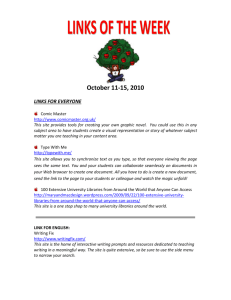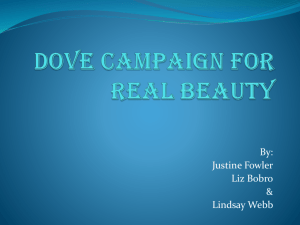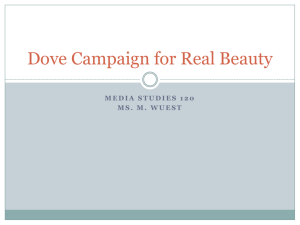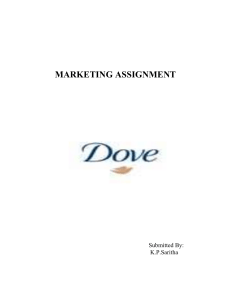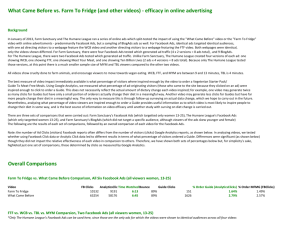Problem!Recognition!and!Information!Search!
advertisement
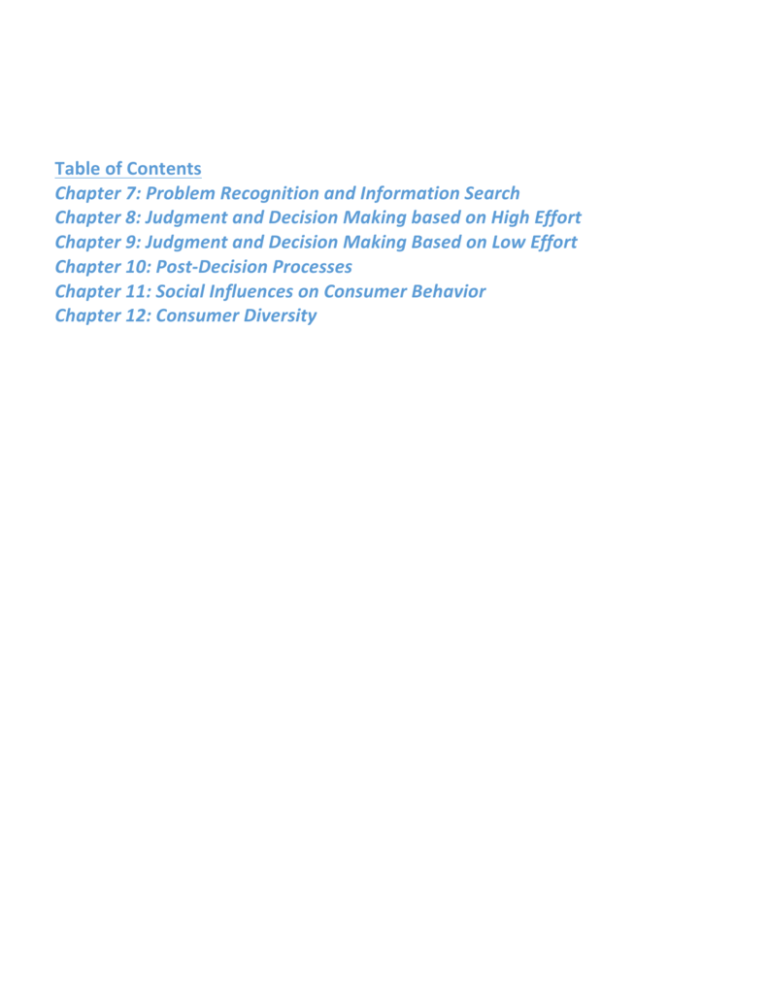
! ! ! ! ! ! Table&of&Contents&& Chapter!7:!Problem!Recognition!and!Information!Search! Chapter!8:!Judgment!and!Decision!Making!based!on!High!Effort! Chapter!9:!Judgment!and!Decision!Making!Based!on!Low!Effort! Chapter!10:!PostHDecision!Processes! Chapter!11:!Social!Influences!on!Consumer!Behavior! Chapter!12:!Consumer!Diversity! Chapter!7:!Problem!Recognition!and!Information!Search! Lecture 9 (10/3/14) – Online Unit 7 – Problem Recognition and Information Search Project Recognition Learning Objectives - To understand consumer problem recognition and the decision making process o Ex: Adidas has a warranty (solution) – (problem: Close drags her toe when playing tennis) - To know how & why consumers conduct internal search o Internal search: when you go back in your mind and think about your experience with a particular brand - To know how & why consumers conduct external search o External search: going out into the world to talk about and search for information about a particular brand and solve a consumption problem - To access challenges marketers face in influencing consumers’ searches Problem: actual state (where we are now) vs. ideal state (where we want to be) - Problem recognition: the disconnect between actual and ideal states - 10 years of Dove ‘Real Beauty’: example of delineating the idea of ideal self vs. actual self o Thinking about beauty in a bad way (i.e. Barbie) o Think back to the first time you saw a Dove “Real Beauty” ad. What was your initial reaction? o Celebrities speaking out against Photoshop and airbrushing o Selfie campaign (#nofilter) – Dove campaign o Some makeup companies use anxiety/fear appeals to make consumers think that they need those products to be beautiful o Ogilvy & Mather, Toronto ! “Evolution” – Photoshop of a woman that looks nothing like her on a billboard ! “Onslaught” – a video collage of lots of photoshopped ads ! “Sketches” – women describing themselves vs. other people describing what they see in the women • “You are more beautiful than you think o Can Dove claim moral high ground when Unilever also produces Slim-Fast and Axe? Problem Recognition - Stimulating Problem Recognition o Creating a new ideal state ! Not saying “let’s make a problem” – don’t make something new up just to create a new ideal state ! Also a function of our future goals and aspirations • Ex: buying athletic shoes for looks, because they’re really runners, etc. – why do you buy what you buy? o Create dissatisfaction with actual state ! Ex: Tic Tac “stranger on the subway” ad – suggesting to people that they may need fresh breath ! Ex: Dove deodorant – it’s clear, won’t be white under your arms o Position as solution to problem The Next Step: Internal Search - Definition: searching for information from memory Lecture 10 (10/6/14) – Online Information Search Degree of internal search can vary between “I’ve seen that” to extensive searches for relevant information External marketing: take the next step and go through the memory of internal search and search externally for information in the environment - Facebook to make targeted ads more transparent for users o Were criticized for lack of transparency o Agreed to start displaying the little blue “AdChoices” icon on its display ads served through it FBX ad exchange ! Intended to provide enhanced notice of behavioral targeting and allow users to opt out ! All ads are targeted by using third-party data ! Facebook takes users’ data to target the ads ! Goal: enhance awareness to users o Are the ads you see on Facebook relevant to you? o Have you ever hid an ad on Facebook? o Do you feel that advertising on Facebook is ethical? Does it feel intrusive? - Behavior targeting o Big data helps with measuring behaviors instead of attitude - Collusion for Chrome: a visual representation of who are getting your data - Pre-purchase search vs. Ongoing search o Pre-purchase search: response to problem recognition ! Determinants • Involvement in the purchase • Market environment • Situational factors ! Motive: to make better purchase decisions ! Outcomes • Increased product and market knowledge • Better purchase decisions • Increased satisfaction with the purchase outcome o Ongoing search: have a continuous basis of searching even if problem recognition is not activated ! Determinants • Involvement with the product • Market environment • Situational factors ! Motives • Build a bank of information for future use • Experience fun and pleasure ! Outcomes • Increased product and market knowledge leading to: o Future buying efficiencies o Personal influence • Increased impulse buying • Increased satisfaction from search and other outcomes - Sources of External Information o Retailer - o Media o Interpersonal ! Word of mouth o Independent o Experiential o Internet ! Keyword search ! Shopping agents ! Information overload ! Simulations ! Online community Measures of Online Consumer Activity o Ad impressions: (opportunity for communication) – How many consumers are exposed to a particular web ad? o Unique visitors: (message exposure) – How many different consumers visit the site during a given period of time? o Click-through rate: (effectiveness) – How many consumers who are exposed to a message actually click on it for additional information? o Percentage of repeat visits: (consumer loyalty) – How many visitors in a given period have visited the site previously? o Frequency of visits: (consumer loyalty) - how often does a visitor visit the site in a given period of time? o Top entry page: (message and offer effectiveness) – Which page does the visitor enter? o Top exit page: (message and offer effectiveness) – Which page does the visitor exit the site? o Visitor path: (message and offer effectiveness) – How do consumers navigate the site? o Conversion rate: (offer effectiveness) – What percentage of visitors actually buys? o Cart abandonment rate: (offer and interactivity effectiveness) – What percentage of visitors put items into carts but fail to complete checkout? Attribute Recall - Accessibility/availability - Diagnosticity - Salience: how prominent is that attribute - Vividness - Goals Is Internal Search Accurate? - Confirmation bias – Draw attention to negatives of competition o The higher likelihood that we can recall information that aligns with and reinforces our beliefs o Ex: show pictures of Disney World and hyper-imposing WB characters into old family photos - Inhibition o Consumers don’t always consider key aspects ! Ex: girls wearing barely anything handing out RockStar energy drink o Consumers recall other more accessible attributes - Mood o If you’re in a bad mood, it prevents you from making clearheaded decisions o Memory is a function of your mood Effort to Process Information - Influenced by: o Motivation


